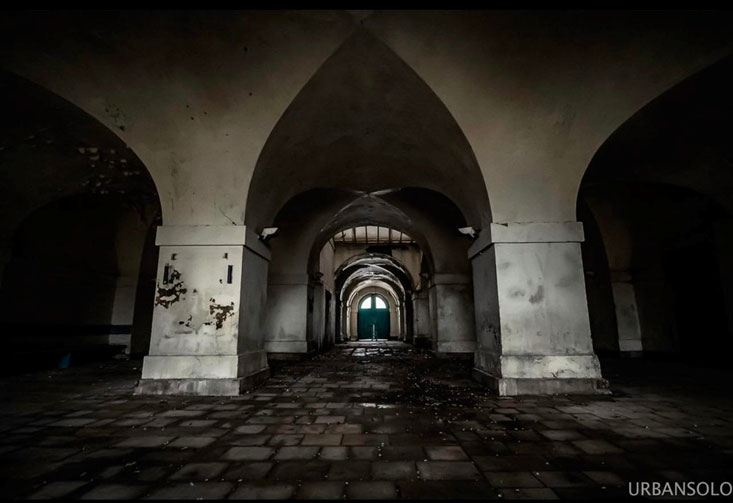
HASLAR!
Alan Dearling shares some of the secrets discovered by Urban Solo
On the south coast of England, Royal Hospital Haslar was historically an important hospital, originally a naval facility built over Haslar Creek on the outskirts of Gosport in Hampshire. It overlooks the Solent, with the Isle of Wight in the near, often grey and misty distance. A lot of its history was bound up with the treatment of military personnel – much of which work was psychiatric, it incorporated an asylum, and at one time a lot of the treatments were based on the now debunked

‘science’ of phrenology. It was also apparently the location of the first major UK ‘blood bank’. Very recently, most of the hospital site has been redeveloped into luxury waterfront retirement apartments, but a part of the old hospital is still intact, but being gradually demolished. It is subject to security patrols and control. This is a place where Urban Solo and colleagues have been visiting over a period of years – including very recently!
They are Urban Explorers. Here’s a link to two of the UK sites about ‘urban exploration’ – including a range of information about Who they are, What they do. And, Why!
28 Days Later: https://www.28dayslater.co.uk/
The Urban Explorer: https://www.theurbanexplorer.co.uk/
What urban exploration seems to be, is different for different individuals. Some are amateur historians and archaeologists. Some are climbers, cavers, sportswomen and men. Some are excitement junkies. Many, or perhaps most urban explorers, are curious, inquisitive, active and ‘seekers’. Theirs can be an occasional hobby, an adrenalin-fuelled adventure, or, a gateway to ‘way of life’. Or, even verging on the obsessional…
A lot of urban exploration occupies a borderline of ‘legality’. Entering abandoned, decaying, empty, guarded or unguarded old(er) buildings. Photos and video are the ‘records’ of such explorations, not physical objects. Many urban explorers invest large sums of money on ‘gear’ for recording and for other aspects of the explorations, such as communications between team members. There is risk and danger, and in some cases the possibility of a criminal conviction and potential punishment. There’s no single set of rules, but most (but not all) adhere to a code of behaviour that loosely follows the dictum set out by author, Jeff Chapman, editor of the zine, ‘Infiltration’. He suggests that genuine urban explorers, “Never vandalise, steal or damage anything.” The thrill comes from “discovery and a few nice pictures.”
Urban Solo’s small team of Urban Explorers visited (actually re-visited) Haslar over a recent weekend. Their findings, photographs and video are concerning. Worrisome in fact, as many patient files are still at the site – abandoned, and far from private and confidential.
A bit of Haslar history
From Wikipedia:
“The hospital’s remit became tri-service in 1996 when it reverted to being called the Royal Hospital Haslar. A hyperbaric medicine unit was established at the hospital at that time. To mark the handover of control to the National Health Service in 2007, the military medical staff ‘marched out’ of the hospital in 2007, exercising the unit’s rights of the freedom of Gosport.
All remaining medical facilities at the site were closed in 2009.”
“The Admiralty acquired the site selected for the hospital, Haslar Farm, whose name came from Anglo-Saxon Hæsel-ōra (English: Hazel Bank), in 1745. The building was designed by Theodore Jacobsen and construction of the main building was completed in on 23 October 1753. On completion it was the largest brick building in Europe. Building works cost more than £100,000, nearly double the cost of the Admiralty headquarters in London. In its early years it was known as the Royal Hospital Haslar.”
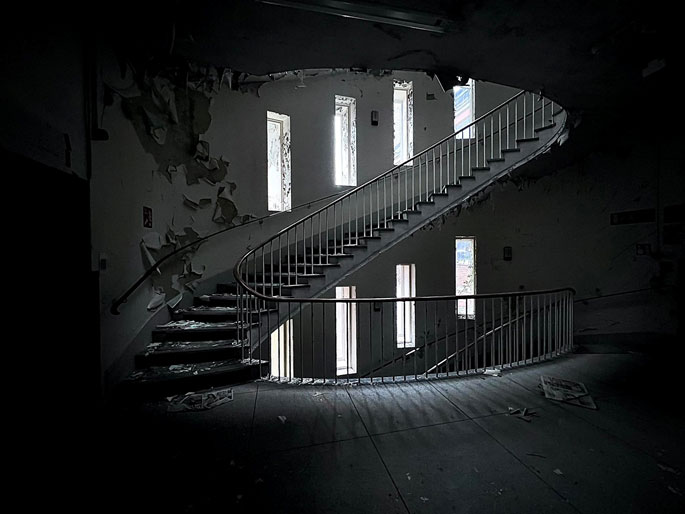
At its closure, the hospital reverted to the original name.
The hospital has something of a mucky past history. For instance, the BBC local Hampshire history site recalls that:
“When Haslar first opened, some compared it to a prison. There were overcrowded buildings, discharged patients taking up home in the attics and reports of drunkenness and petty theft among staff and patients.
It’s said that buried in the paddock to the south-west of the hospital are tens of thousands of servicemen, and is thought to be the densest area of burial in the UK of those who died serving their country.”
The burial site was investigated by the Channel 4 TV Time Team along with experts from the Cranfield Forensic Institute, in a programme entitled: ‘Nelson’s hospital’, which aired their findings in 2010, saying that,
“It established that a large number of individuals (calculated as approximately 7,785) had been buried in unmarked graves.”
Time Team video: https://www.youtube.com/watch?v=F79AZSjZo84
According to the Portsmouth D-Day Museum: “Between 1944 and July 1945 the United States Military ran the hospital treating Allied D-Day casualties and wounded German prisoners of war. To cope with the large numbers of casualties arriving at Haslar the basement was used for two operating theatres. The casualties taken to Haslar in the three months of the D-Day landing period was 1,347 out of the 17,566 casualties received.”
The Abandoned Royal Haslar Hospital

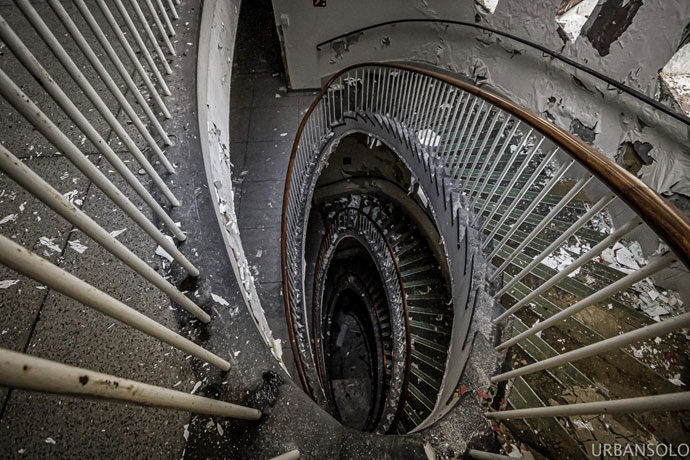
Beautiful Staircase takes you all the way to the roof.
Words from Urban Solo at Haslar Royal Hospital
“After 5 years, 3 failed attempts and we are in. Just a shame that many of her wonders have been destroyed!
New Year’s Eve 2021 bag is packed, unpacked and packed again. Camera, batteries, tripod, climbing rope. Gloves, first aid kit, head torch, food and drink. The list goes on. I’ll soon to regret taking so much stuff.
4:30 am New Year’s Day 2022 and I am out the door. Thankfully a short journey in and I am soon looking at the fence.
Having had Covid over Xmas I wasn’t looking forward to the climb.
Over I go, I know I’ve got to be quick, I am right under a camera, time is not on my side as Haslar has one of the most highly regarded security teams and camera systems .
Get to the second fence, under this one.
CAR !!!!!!
That’s them. I am at the face of the main building, and darkness is on my side.
I find a door and it’s open. But I have company.
Hiding in the shadows for what is an eternity – then the security gives up.
I make my way to the main staircase and hide up and wait for the sun.
Mind-blowing.
Sun’s up, and it shows Haslar off, in all her glory.
Room after room of equipment, just left to rot. Surely it must be worth something…££££
But no, it’s being dumped in skips…
Sadly this is the true reality of today’s Society.

One of 3 scanners left in this part of Haslar. There were many more in the newer part, now demolished
What’s left now is nothing compared to what was left. But the most shocking find was yet to come. On a return trip to Haslar to explore with two friends.
After a 12 hour stint I felt I’d seen what there was to see and slowly made my way home, feeling rather tired.”
Second explore.
“Three of us this time, urban-not-so-solo for this one.
Run-up to the exploration was the same really, apart from a few more beers and an early night. Covid, a distant memory.
We made our way to the hospital, early doors again, as darkness is our friend.
Fences done and we are in. We hide up, take some refreshments and start our explorations.
Something about being in an abandoned hospital puts you on edge!!!
Well, for some of us.
We find our way to the basement level, it’s massive. Good torch needed.
The second room we come to. Files everywhere, medical files…Names, addresses, DOB, current age at time of operation. We all look at each other, for a second we all think this is cool to find, but then the realisation kicks in that this is all confidential info that shouldn’t be here. Why is it here? Records from 1981 to 2000.
This is WRONG.
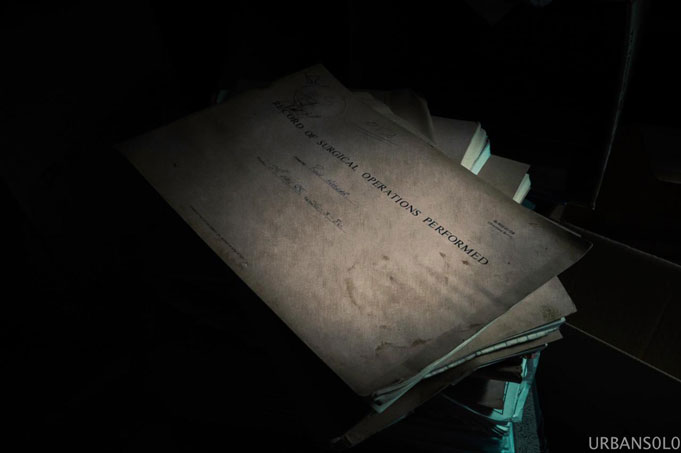
I’ll finish my account tomorrow. Falling asleep.”
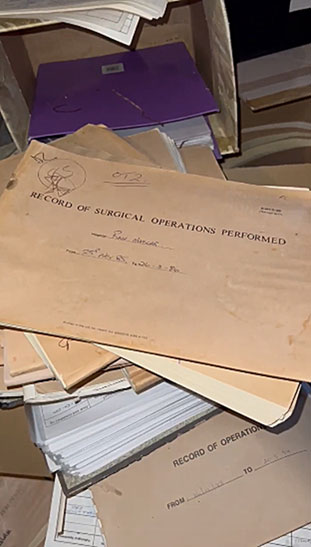
Patient Records. I was shocked to find this information. Surgical Information and medical records with names, addresses and age for all to see. Very naughty!
Sent from my iPhone
“We continue on from our find through the maze of tunnels and room under Haslar and I find myself entering tunnels under the basement level. Sadly I wasn’t able to go further, as they look like they flood and are full of mud. We come to a section that is lit up like a Xmas tree, we can hear voices! We remain as stealthy, quiet as possible. I poke my head around the corner to see to builders sat down having a chin-wag and cup of tea. Oh boy, would I have loved to scare the shit out of them. But we back off and make our way to the nuclear medicine section of the hospital, with part of a lab and a few scanners dotted about.
We get to the lab. Cameras at the ready, as there are a few good shots to be had here. After the lab, down to the remaining theatres/sadly gone in the last week!
Then we start thinking of our way out! By this time the place is crawling with people. So, the way in is a big, ‘No-No’.
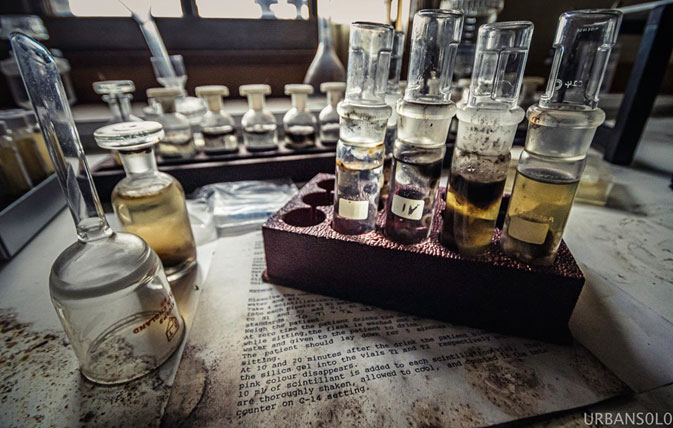
Haslar Lab. This lab is opposite the Nuclear Medicine section. Lots of nasty stuff in here.
After a few more sections of the hospital we find ourselves on the ground level. One of the group has a bright idea. Let’s just walk out of the front gate. Well, why not.
As we walked closer to the security, we hear voices, and around the corner we see a guard looking straight at us, and another shouts out, ‘Who are you?’ The other guard just comes out with: ‘I don’t want anything to do with this.’
And that was it, we were out.
Since then, I met a security guard on site, he threatened me with physical violence. And anyone else that came onto site. I had to laugh, I’m sure that didn’t help matters, but the gentleman couldn’t even dress himself properly.
Let alone catch me.
Since then I’ve be in 2 more times without any bother…”
Urban Solo.
“Thank you Alan for helping to share…”
